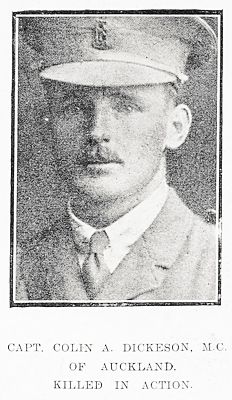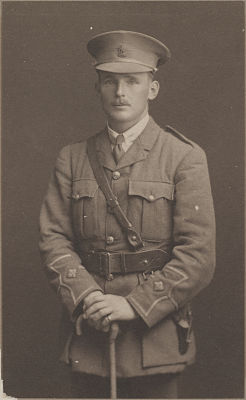WW1 Captain Colin Addison Dickeson M.C. 24/2128
Colin Addison Dickeson (24/2128) was born on 20 March 1888 in Kaikohe, Northland to George Frederick Dickeson (who died in 1914 after a prolonged illness) and Eleanor Dickeson (Edmonds).
There were four sons and a daughter; Frank Dickeson and Clifford George Dickeson (40670) living in Kaikohe, Thurston Wyatt Dickeson in Auckland, and a daughter, Liddy Sara Rose Dickeson married to Frank Goldie in Auckland. Eleanor Dickeson subsequently moved to Victoria Avenue, Remuera. [1] Colin was a member of the College Rifles Rugby Union Football and Sports Club in Remuera and was a keen hockey player for the United Club. In 1912, on his departure to England to further his architecture studies, the club presented him with a suitably inscribed travelling rug. [2, 3] In London he received his diploma, A.R.I.B.A. with honours, in June, 1911.
Colin married Laura Elizabeth Robinson at Woolhara, Sydney, 25 February 1915 and they lived in Mt Albert, Auckland. Colin enlisted and on 1 April 1916, sailed on the HMNZT ‘Tahiti’ arriving in Suez, Egypt on 1 May 1916, as a Second Lieutenant, with the 5th Reinforcements, 2nd Battalion, F Company, New Zealand Rifle Brigade. On 10 November 1916, he was transferred to New Zealand Cyclist Corps. The New Zealand Cyclist Corps, formed to train men to be mounted riflemen, arrived on the Western Front in July 1916 and participated in offensives at Messines and Passchendaele in 1917. Like mounted riflemen, they performed scouting and reconnaissance work but were of little value in trench warfare conditions, so spent much of their time on other types of war work. They were particularly involved with burying telegraph cables, and at times served in the trenches as infantrymen. [4]
On the 15 January 1918 Colin was awarded the Military Cross for Gallantry: For conspicuous gallantry and devotion to duty when cable burying operations were in danger of being stopped owing to difficulties, through the rain, mud, darkness, and enemy shelling, of getting materials forward to the work. His party preserved, and so enabling the work to proceed. (London Gazette, 23 April 1918, p4889). Colin had been promoted to Lieutenant on 19 September 1917.
Between April and July 1918, on the Western Front, the German Army launched more offensives, the first was, Operation Georgette (9–29 April 1918) in Flanders, which pushed the British out of Passchendaele and Messines, territory won at such cost the previous year, but failed to capture the important Hazebrouck rail hub. New Zealand units were involved here too, helping stop the German advance in the Battle of the Lys. New Zealand gunners of the New Zealand Field Artillery’s 2nd (Army) Brigade fought valiantly to support defending troops near Messines. Mounted rifles, cyclist, entrenching and employment company troops were also involved. They filled crucial gaps in the line south-east of Ypres, fighting as de facto infantrymen at ‘Shrewsbury Forest’ (near Hill 60), Méteren, Mt Kemmel, Vierstraat Road and Hill 44 before being withdrawn. Colin was killed in action on 26 April 1918 aged 30 near Ypres in Flanders, Belgium. [5]
He is buried at Lijssenthoek Military Cemetery, Poperinge, West-Vlaanderen, Belgium, Plot 28, Row C, Grave 5 Colin Addison Dickeson (24/2128) is remembered in the Roll of Honour, College Rifles, Rugby Union Football & Sports Club, 33 Haast Street, Remuera, Auckland, and All Saints Church, 284 Ponsonby Road, Ponsonby, Auckland.

